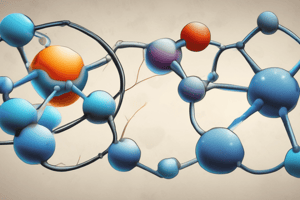Podcast
Questions and Answers
What characteristic do giant covalent structures share due to their strong covalent bonds?
What characteristic do giant covalent structures share due to their strong covalent bonds?
- Low melting and boiling points
- High melting and boiling points (correct)
- Excellent electrical conductivity
- Flexible and ductile nature
Which of the following is NOT a typical property of giant covalent structures?
Which of the following is NOT a typical property of giant covalent structures?
- Brittleness
- Poor electrical conductivity
- High electrical conductivity (correct)
- Hardness
Which giant covalent structure is known for having a tetrahedral arrangement of carbon atoms?
Which giant covalent structure is known for having a tetrahedral arrangement of carbon atoms?
- Silicon dioxide
- Graphite
- Limestone
- Diamond (correct)
What allows graphite to conduct electricity?
What allows graphite to conduct electricity?
Which statement about silicon dioxide (SiO₂) is true?
Which statement about silicon dioxide (SiO₂) is true?
Why are giant covalent structures often brittle?
Why are giant covalent structures often brittle?
Which of the following best describes the bonding in graphite?
Which of the following best describes the bonding in graphite?
What type of bonds are present in giant covalent structures?
What type of bonds are present in giant covalent structures?
Flashcards
Covalent Bond
Covalent Bond
A chemical bond formed when two or more atoms share pairs of electrons, allowing them to achieve a stable electron configuration.
Polar Covalent Bond
Polar Covalent Bond
A type of covalent bond formed when atoms with different electronegativities share electrons unequally, creating partial positive and negative charges.
Nonpolar Covalent Bond
Nonpolar Covalent Bond
A type of covalent bond formed when atoms with similar electronegativities share electrons equally, resulting in no partial charges.
Giant Covalent Structures
Giant Covalent Structures
Signup and view all the flashcards
Diamond
Diamond
Signup and view all the flashcards
Graphite
Graphite
Signup and view all the flashcards
Silicon Dioxide (Quartz)
Silicon Dioxide (Quartz)
Signup and view all the flashcards
Electrical Conductivity
Electrical Conductivity
Signup and view all the flashcards
Study Notes
Covalent Bonds
- Covalent bonds form by sharing electrons. This sharing allows each atom to achieve a stable electron configuration, often the octet rule.
- The shared electrons are attracted to the nuclei of both atoms, holding them together.
- Covalent bonds typically occur between non-metal atoms.
- Bond strength varies depending on the type and number of atoms involved (e.g., single, double, or triple bonds).
- Polar covalent bonds occur when atoms with different electronegativities share electrons unequally, creating partial positive and negative charges.
- Nonpolar covalent bonds occur when atoms with similar electronegativities share electrons equally.
Giant Covalent Structures
- Giant covalent structures, also known as macromolecules, are composed of a large number of atoms covalently bonded together in a continuous network or lattice.
- These structures have high melting and boiling points due to the strong covalent bonds throughout the entire structure.
- They are typically hard and brittle because breaking the network requires overcoming numerous very strong bonds.
- They are often poor conductors of electricity because the electrons are localized within the bonds.
- Examples of giant covalent structures include diamond, graphite, and silicon dioxide (quartz).
Diamond
- Each carbon atom in diamond is bonded to four other carbon atoms in a tetrahedral arrangement.
- Diamond has a very high melting point and is extremely hard due to the strong covalent bonds.
- Diamond is an electrical insulator due to the lack of free electrons.
Graphite
- Each carbon atom in graphite is bonded to three other carbon atoms in a layered hexagonal arrangement.
- The layers are held together by weak van der Waals forces.
- This allows the layers to slide over each other, giving graphite its slippery feel and making it a good lubricant.
- Graphite conducts electricity because delocalized electrons are free to move between the layers.
Silicon Dioxide (Quartz)
- Silicon dioxide (SiO₂) is a giant covalent structure where each silicon atom is bonded to four oxygen atoms, and each oxygen atom is bonded to two silicon atoms.
- This structure forms a continuous network of SiO₄ tetrahedra.
- Silicon dioxide has a high melting point and is hard.
- It is an electrical insulator.
Properties of Giant Covalent Structures Summary
- High melting and boiling points: Strong covalent bonds throughout the structure require a lot of energy to break.
- Hardness and brittleness: A large network of strong covalent bonds; breaking the structure requires overcoming many bonds, resulting in a brittle material.
- Poor electrical conductivity: Electrons are localized within the bonds and are not free to move; exceptions include graphite, which exhibits conductivity due to delocalized electrons.
- Insoluble in water: Primarily because of the strength of the covalent bonds.
Studying That Suits You
Use AI to generate personalized quizzes and flashcards to suit your learning preferences.




